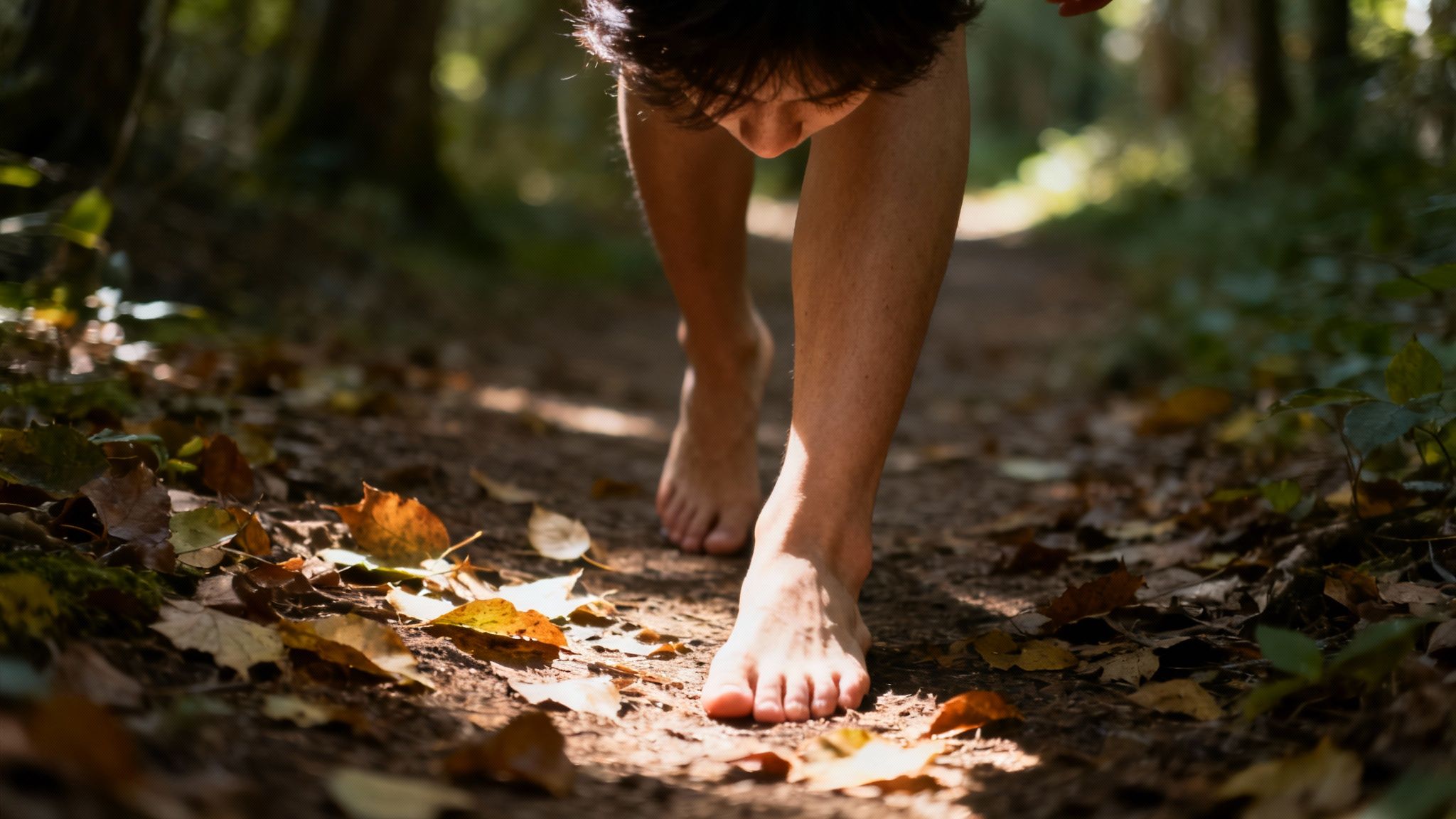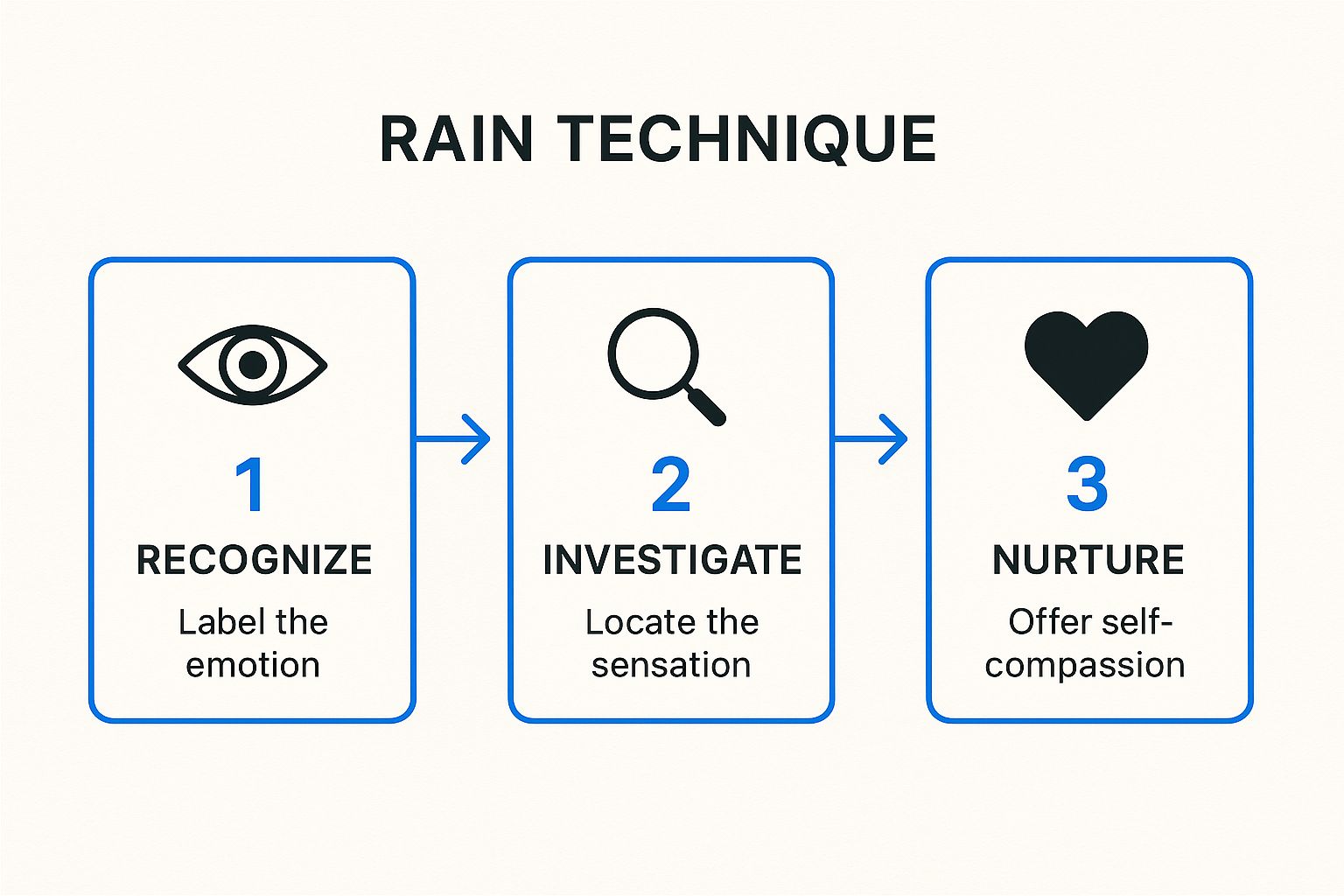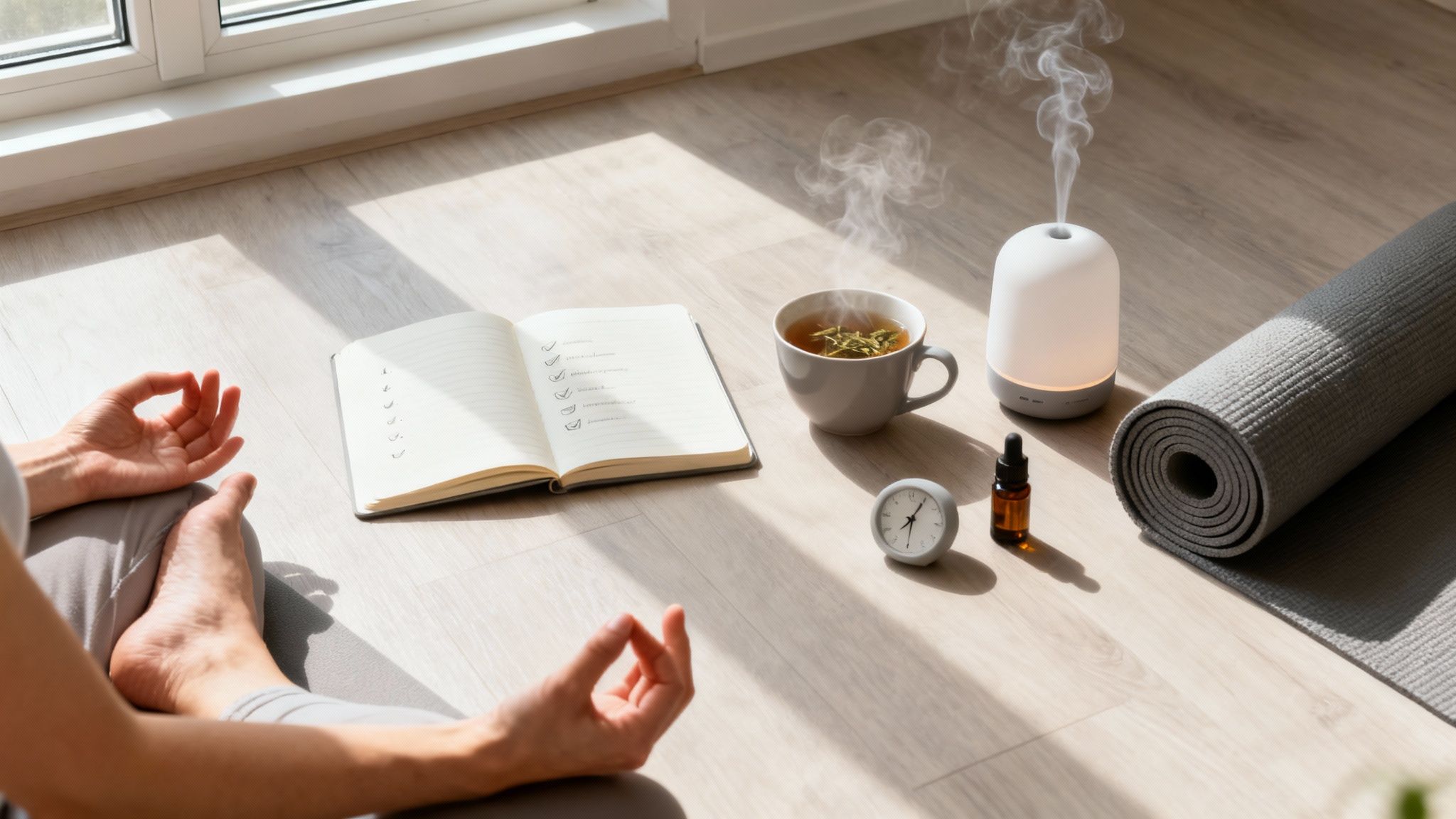In today's fast-paced world, feeling stressed, anxious, or overwhelmed is a common experience. The demands of our personal and professional lives can sometimes lead to workplace stress and burnout, impacting our overall well-being. This article explores practical mindfulness techniques for stress to help you find calm and build a strong foundation for emotional balance.
Mindfulness is the simple practice of paying attention to the present moment on purpose and without judgment. It's a skill that builds resilience, enhances self-compassion, and can foster a greater sense of happiness. By connecting with the here and now, you can learn to navigate difficult feelings linked to anxiety and depression with more ease. For a broader approach to mental calm, you might find value in this gentle guide to calming your mind and finding inner peace.
This guide offers eight proven methods to support your mental wellness journey, explained in warm, clear language. Rooted in an India-first context with global relevance, these informational techniques are tools for well-being, not diagnostic assessments or a replacement for professional therapy or counselling. Let’s explore how you can cultivate a more balanced and mindful life.
1. The Anchor of Now: Mindful Breathing (Breath Awareness Meditation)
Mindful breathing is the foundation of many mindfulness techniques for stress. It involves focusing your attention on the natural rhythm of your breath. This simple act anchors you in the present moment, guiding your focus away from anxious thoughts.
This practice helps activate the body's relaxation response, which can lower stress hormones and slow your heart rate. Popularised in the West, its power lies in its simplicity and accessibility for managing stress and promoting well-being.
Why It's a Powerful Tool for Stress
This technique is especially helpful for managing immediate stress. When you feel overwhelmed by workplace stress or a sudden wave of anxiety, focusing on your breath offers an instant point of concentration. The Indian Army incorporates similar tactical breathing to enhance focus, while the NHS in the UK often suggests it for managing anxiety.
How to Practise Mindful Breathing
Getting started is simple and requires no special equipment. Here are some tips to integrate this into your routine:
- Start Small: Begin with just two to three minutes a day. Consistency is more important than duration when building a new habit.
- Use a Tangible Anchor: Place one hand on your belly to feel the rise and fall with each breath, giving your mind a concrete sensation to focus on.
- Practise the 4-7-8 Technique: A calming method popularised by Dr. Andrew Weil involves inhaling for 4 counts, holding for 7, and exhaling for 8.
- Don't Judge Your Thoughts: Your mind will wander; that's natural. When it does, gently guide your attention back to your breath without criticism.
- Use Guided Resources: Apps like Calm or Insight Timer offer guided breathing meditations that can help structure your practice, which is especially useful for beginners.
2. Body Scan Meditation
Body Scan Meditation is a practice that cultivates a deep connection between your mind and body. It involves guiding your attention through different parts of your body, noticing sensations like warmth or tension without judgment. This is one of the most effective mindfulness techniques for stress for those who carry tension physically.

Popularised as part of Mindfulness-Based Stress Reduction (MBSR), the practice helps you tune into your body's signals. By simply noticing physical sensations, you can consciously release accumulated stress from challenges like workplace stress and improve your well-being.
Why It's a Powerful Tool for Stress
This method is potent for managing chronic stress and physical discomfort that often come with anxiety and burnout. It trains the mind to observe sensations objectively rather than reacting to them. Major corporations like Apple and Nike include body scan sessions in their wellness programs to enhance employee resilience and well-being.
How to Practise Body Scan Meditation
Lying down comfortably is ideal for this practice, making it a perfect pre-sleep routine. Here are some actionable tips:
- Use Guided Recordings: When starting, guided meditations are invaluable. Apps like Headspace or Insight Timer have excellent guided body scans.
- Practise Before Bed: Performing a body scan in bed can significantly improve sleep quality by calming your nervous system and body.
- Notice Without Judging: The goal is to notice sensations, not change them. Acknowledge tightness, pain, or ease with gentle curiosity.
- Pace Yourself: Spend about 30-60 seconds on each major body part, such as your feet or abdomen, before moving to the next.
- Return Gently: Your mind will naturally wander. When you notice this, gently guide your focus back to the part of your body you were attending to.
- Stay Warm: As you relax, your body temperature might drop slightly. Keep a light blanket nearby to stay comfortable.
3. Mindful Walking
Mindful walking transforms the everyday act of moving into a powerful meditation. It involves bringing your full, non-judgmental awareness to the physical sensations of walking. This mindfulness technique for stress shifts your focus from the destination to the journey itself.

This practice grounds you in the present moment through movement, making it a great alternative for those who find seated meditation difficult. It connects the mind and body, helping to soothe anxiety by engaging your senses directly with the here and now.
Why It's a Powerful Tool for Stress
This technique is valuable for managing workplace stress and integrating calm into a busy schedule. A short mindful walk can physically and mentally reset your state, reducing feelings of being overwhelmed. The Japanese practice of Shinrin-yoku (forest bathing) combines mindful walking with nature to lower cortisol, while companies like Salesforce encourage it to boost employee well-being and resilience.
How to Practise Mindful Walking
You can practice mindful walking anywhere, from an office corridor to a quiet park. Here are some tips to get started:
- Start with Short Sessions: Begin with just five minutes of mindful walking. As you become more comfortable, you can extend the duration.
- Focus on Each Movement: Pay close attention to the sensation of lifting one foot, moving it through the air, and placing it back down.
- Coordinate Breath with Steps: Try synchronizing your breath with your steps, such as inhaling for three steps and then exhaling for the next three.
- Walk Barefoot: If you are in a safe, natural space like a grassy lawn, try walking barefoot to enhance the sensory feedback from the ground.
- Use it as a Transition: Take a mindful walk when moving between tasks. This can act as a mental palate cleanser, helping you refocus.
- Choose a Quiet Path: When possible, find a route with minimal distractions to deepen your practice and sense of well-being.
4. Loving-Kindness Meditation (Metta)
Loving-kindness meditation, or 'Metta', is a practice focused on cultivating unconditional compassion and goodwill. It involves silently repeating phrases that extend warmth and well-wishes first to yourself, and then to others. This can transform your relationship with stress born from conflict or self-criticism, fostering resilience.
This technique shifts your mental state from judgment to acceptance and connection. By generating feelings of warmth, you actively counter the brain's negativity bias, reducing the emotional charge of stressful situations and promoting happiness.
Why It's a Powerful Tool for Stress
This mindfulness technique for stress is uniquely effective for managing emotional and interpersonal challenges. When facing workplace conflict or harsh self-judgment, Metta offers a way to soften your heart and approach the situation with greater empathy. Healthcare organizations are now using compassion meditation to help professionals prevent burnout and manage emotional tolls.
How to Practise Loving-Kindness Meditation
You can begin this heartfelt practice with just a few minutes a day. Here are some actionable tips:
- Start With Yourself: Always begin by directing kind phrases toward yourself. Repeat phrases like, "May I be safe. May I be happy. May I be healthy. May I live with ease."
- Personalise Your Phrases: If the traditional phrases don’t resonate, change them. You might prefer, "I wish myself peace," or "May I feel strong today."
- Visualise the Recipient: When extending wishes to others, picture them in your mind. This makes the practice more vivid and heartfelt.
- Combine with a Gesture: Place a hand over your heart as you offer kindness to yourself. This physical touch can deepen the feeling of self-compassion.
- Be Patient with 'Difficult People': Only extend Metta to those you have friction with after you are comfortable directing it towards yourself and loved ones. It is a gradual process.
5. The RAIN Technique: Navigating Emotional Storms
The RAIN technique is a structured mindfulness practice to help you work through difficult emotions rather than suppressing them. Developed by mindfulness teachers, it provides a clear, four-step process. This method transforms your relationship with stress, creating a crucial pause between a trigger and your reaction.
The infographic below illustrates the core steps of the RAIN process, offering a visual guide to this powerful technique.

This simple flow provides a structured pathway to process difficult emotional experiences. By moving through these stages, you build resilience and self-compassion.
Why It's a Powerful Tool for Stress
RAIN is exceptionally effective for processing intense emotions that accompany workplace stress or anxiety. It is widely used in therapy and counselling; for instance, addiction recovery programs in India employ it to manage cravings. It provides a practical framework for emotional regulation and well-being.
How to Practise the RAIN Technique
You can apply this four-step process anytime you feel a strong emotion rising. Here are some tips to integrate RAIN into your life:
- Recognise What’s Happening: Pause and mentally name the feeling. For example, say to yourself, "This is anxiety," or "Anger is here."
- Allow the Experience to Be There: Gently give the feeling permission to exist without trying to fix it. You might whisper internally, "It's okay to feel this."
- Investigate with Kindness: Turn your attention inward with curiosity. Ask yourself, "Where do I feel this in my body?" or "What does this emotion need right now?"
- Nurture with Self-Compassion: Offer yourself a gesture of kindness, like placing a hand on your heart or offering kind words. This step provides comfort and care.
- Start with Minor Irritations: Practice RAIN with small stressors, like being stuck in traffic, before applying it to more intense situations to build the skill.
6. Mindful Observation (Open Awareness)
Mindful observation, or open awareness, is a practice that trains your attention on a single object in your environment. Whether it's a flower or a cup of tea, the goal is to observe it with full sensory awareness, free from judgment. This technique interrupts the cycle of stress-generating thoughts by anchoring your mind in the tangible world.
The practice shifts your focus from internal mental chatter, which often fuels anxiety, to external sensory input. Popularised through the famous "raisin exercise," it shows that even a mundane object can be a gateway to presence and peace.
Why It's a Powerful Tool for Stress
This technique is effective for breaking free from repetitive negative thinking. When you're caught in a loop of worry about workplace stress, mindful observation provides an escape route. Nature-based therapy programs in India often use mindful observation to help individuals manage symptoms of anxiety and depression, grounding them in the natural environment.
How to Practise Mindful Observation
Integrating this practice requires only a willingness to see the world with fresh eyes. Here are some actionable tips:
- Start with a 'Beginner's Mind': Choose an object, perhaps the cup of chai you have every morning, and pretend you are seeing it for the very first time.
- Keep a 'Mindfulness Object': Place a small object like a smooth stone on your desk. When stress rises, take a two-minute break to simply observe it.
- Engage All Senses: The "raisin exercise" is a classic example. Look at it, feel it, smell it, and finally, taste it slowly, observing the flavor.
- Use the 5-4-3-2-1 Technique: Ground yourself by naming: 5 things you can see, 4 things you can feel, 3 things you can hear, 2 things you can smell, and 1 thing you can taste.
- Don't Strive, Just Notice: The goal is simply to observe. When your mind wanders, gently guide it back to the object of your attention.
7. Penning Down Peace: Mindful Journaling
Mindful journaling is a powerful mindfulness technique for stress that combines writing with present-moment awareness. It involves writing about your thoughts, emotions, and physical sensations as they arise, observing them without judgment. This practice helps make overwhelming feelings feel more manageable.
Translating thoughts and feelings into words creates a healthy distance, allowing you to see them more objectively. This method builds self-awareness, a key component of emotional resilience and well-being.
Why It's a Powerful Tool for Stress
This technique is effective for untangling complex emotions tied to workplace stress, anxiety, or burnout. It’s a private and accessible way to engage in self-counselling and identify recurring thought patterns. Corporate wellness programs, like those at LinkedIn, offer journaling sessions to help employees manage job stress and improve well-being.
How to Practise Mindful Journaling
You don’t need to be a writer to benefit; you just need a pen and paper or a digital app. Here are some tips to begin:
- Start with Five Minutes: Begin with a short, achievable goal of five minutes a day. Consistency is more crucial than duration.
- Use Mindful Prompts: Kickstart your session with prompts like, "Right now, I am feeling…" or "I notice in my body…" to anchor your writing in the present.
- Observe, Don't Solve: Write about a source of stress without pressure to find a solution. The goal is to simply observe your thoughts and feelings.
- Incorporate Gratitude: End each session by noting three specific things you are grateful for. This shifts your focus towards positivity and builds resilience.
- Try Morning Pages: This involves writing stream-of-consciousness thoughts upon waking to clear your mind for the day.
- Use Digital Tools: If you prefer typing, apps like Day One or Journey offer secure platforms to support your mindful journaling practice.
8. Mindful Sensory Grounding (5-4-3-2-1 Technique)
Mindful sensory grounding is a powerful mindfulness technique for stress that pulls your awareness out of overwhelming thoughts. It uses your five senses to connect to the present moment, as seen in the popular 5-4-3-2-1 method. This practice involves systematically identifying things you can see, touch, hear, smell, and taste.
The technique works by redirecting your brain's focus from anxiety-fuelling thoughts to neutral, real-world sensory information. This shift interrupts the body's stress response, calming the nervous system and providing immediate relief.
Why It's a Powerful Tool for Stress
This technique is effective for managing sudden spikes in anxiety or panic. When your mind is racing with workplace stress or worry, sensory grounding acts as an emergency brake. Professionals in therapy and counselling use grounding as a core component for helping people navigate intense emotions and feel safe in the here and now.
How to Practise Mindful Sensory Grounding
The 5-4-3-2-1 method is easy to remember and can be done anywhere. Here are actionable tips to integrate this into your well-being toolkit:
- Practise When Calm: Rehearse the technique when you are relaxed. This makes it easier to use automatically during a high-stress moment.
- Be Specific: Instead of just noticing "a chair," describe it to yourself: "I see a brown wooden chair with a smooth surface." Specificity deepens the grounding effect.
- Speak Aloud: If you are in a private space, say what you observe out loud. Hearing your own voice can provide an extra layer of grounding.
- Adapt for the Senses: For taste, you can notice the current taste in your mouth or have a mint or sip of water. For touch, focus on textures like the fabric of your clothes.
- Create a 'Grounding Kit': Keep a small bag with items that have strong sensory properties, such as a textured stone or a small bottle of essential oil.
Mindfulness Techniques: 8-Item Comparison
| Technique | Implementation Complexity 🔄 | Resource Requirements ⚡ | Expected Outcomes 📊 | Ideal Use Cases 💡 | Key Advantages ⭐ |
|---|---|---|---|---|---|
| Mindful Breathing | Low – simple focus on breath, easy to learn | Minimal – no equipment needed, 5–20 mins | Immediate stress reduction, parasympathetic activation | Acute stress, quick calming | Accessible anywhere, scientifically proven, no cost |
| Body Scan Meditation | Moderate – systematic, 10–45 mins | Quiet space, guided audio recommended | Reduces chronic pain, improves body awareness | Insomnia, chronic stress, physical tension | Effective for physical stress, increases emotional regulation |
| Mindful Walking | Low to moderate – slow walking, 5–30 mins | Safe walking space, outdoors preferred | Combines stress relief with physical activity | Restless individuals, integrating mindfulness into daily routine | Combines exercise and mindfulness, grounding benefits |
| Loving-Kindness Meditation (Metta) | Moderate – structured phrases, 10–30 mins | Minimal – quiet space, no equipment | Increases positive emotions, reduces social anxiety | Interpersonal stress, self-criticism, isolation | Enhances empathy, social connection, self-compassion |
| RAIN Technique | Moderate – 4-step cognitive-emotional process | Minimal, 5–20 mins | Enhances emotional intelligence, prevents reactivity | Acute emotional overwhelm, trauma processing | Structured, practical for intense emotions |
| Mindful Observation (Open Awareness) | Low to moderate – focus on external object, 5–15 mins | Suitable object, quiet or public space | Reduces rumination, improves concentration | Those triggered by internal focus, daily routine | Easily integrated, subtle public practice |
| Mindful Journaling | Moderate – writing with mindful awareness, 10–20 mins | Writing materials or digital app | Processes stress, identifies thought patterns | People who express via writing, emotional processing | Tangible record of stress, combines writing & mindfulness |
| Mindful Sensory Grounding (5-4-3-2-1) | Very Low – simple sensory engagement, 2–5 mins | None, portable, can be discreet | Immediate grounding, reduces panic and acute anxiety | Panic attacks, acute stress, anxiety | Fast, easy, discreet, suitable for all ages |
Your Path Forward: Integrating Mindfulness into Your Life
You have just explored a powerful toolkit of mindfulness techniques for stress, each offering a unique pathway to the present moment. These strategies are invitations to reshape your relationship with your mind and emotions. From Mindful Breathing to the compassionate practice of Loving-Kindness Meditation, they provide practical ways to build resilience and find calm.
The journey through these techniques reveals a central truth: you do not have to be swept away by stress, anxiety, or worry. Instead of fighting difficult thoughts, you can learn to observe them with gentle curiosity. This shift in perspective is the heart of mindfulness and is key to greater well-being.
Key Takeaways: Making Mindfulness Your Own
As you integrate these practices into your life, remember the goal is not perfection but presence. The true value lies in discovering which techniques resonate with you and committing to a gentle, consistent practice.
- Start Small and Be Patient: You don’t need to meditate for an hour. Begin with five minutes of Mindful Breathing or a short Mindful Walk. Each time you gently guide your attention back from a wandering thought, you are strengthening your resilience.
- Adapt to Your Needs: These are flexible tools. On a day filled with workplace stress, the 5-4-3-2-1 technique might be your anchor. When dealing with difficult emotions, the RAIN technique can offer insight and self-compassion.
- Mindfulness is Not a Cure, but a Skill: Mindfulness won't eliminate stress, but it builds your capacity to navigate it without being overwhelmed. It cultivates emotional regulation, enhances well-being, and provides a buffer against burnout, anxiety, and depression.
Building a Foundation for Lasting Well-being
By weaving these mindfulness techniques for stress into your life, you invest in your long-term mental health and happiness. This practice fosters a deeper connection with yourself and the world around you. You learn to savour positive moments more fully and approach challenges with greater clarity and self-compassion.
This journey is a powerful step towards personal growth and building resilience against life's challenges. Remember, each breath and each moment of awareness is a victory. You are cultivating a sanctuary within yourself—a place of calm you can always return to.
If you're looking for personalised support to navigate stress, anxiety, or other life challenges, professional guidance can make all the difference. DeTalks connects you with qualified therapists and counsellors across India who can help you integrate these mindfulness practices into a structured plan for your mental well-being. Explore your path to a healthier mind by visiting DeTalks today.





